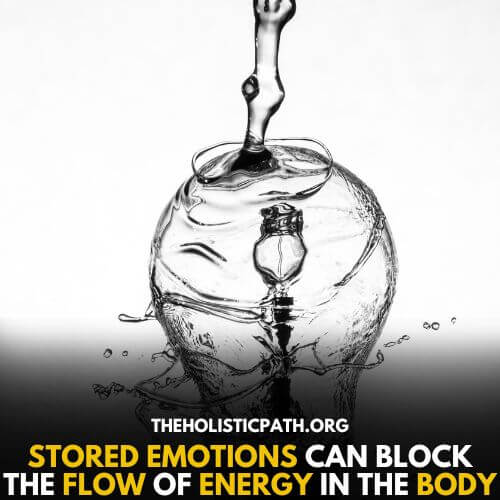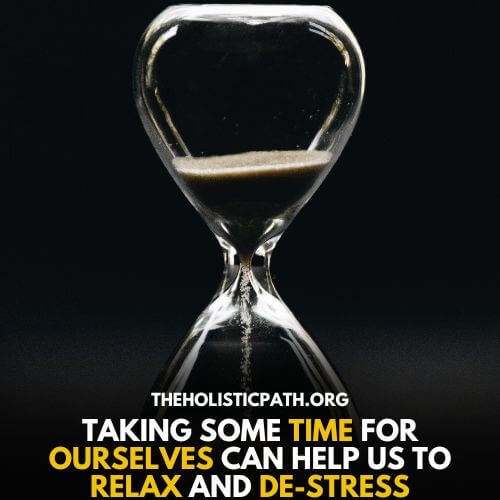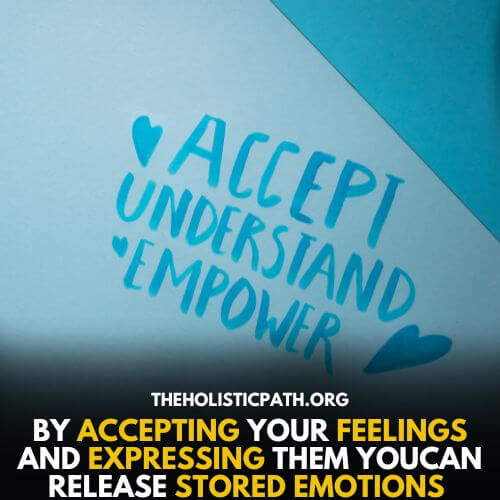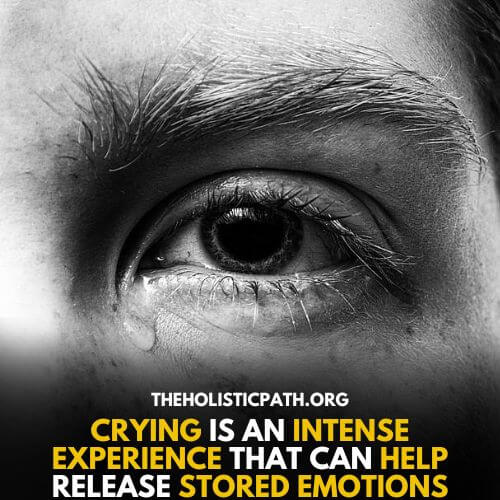When emotions are not expressed in a healthy way, they can get stored in the body. This can lead to all sorts of problems, including physical illness, anxiety, depression, and addiction.
Fortunately, there are some tips on how to release stored emotions that you can follow to release these stored emotions and improve your emotional health.
What Are Stored Emotions, And Why Is It Important To Release Them
Emotions are energy in motion. They are created by the body in response to thoughts and events. Most emotions are short-lived and dissipate once the event or thought that created them is resolved. However, some emotions can be stored in the body.
These are usually negative emotions such as anger, frustration, sadness, fear, and guilt.
Stored emotions can cause physical problems such as tension headaches, back pain, and digestive problems. They can also lead to emotional problems such as anxiety, depression, and addictive behaviors.
The most important reason to release stored emotions is that they block the flow of energy through the body. This also results in the block of the flow of information between the body and the mind and creates a state of imbalance. When the body is out of balance, it cannot function properly.
This leads to physical and emotional problems.
Releasing stored emotions allows the energy to flow freely through the body again. This restores balance to the body and mind and allows them to function normally. It also allows us to feel lighter, happier, and more peaceful.

Identify The Types Of Stored Emotions
The first step in identifying the types of stored emotions is to understand how emotions are typically expressed. Emotions are expressed through facial expressions, body language, and tone of voice.
Once you have a good understanding of how emotions are typically expressed, you can start to look for specific expressions that may indicate that an emotion is being stored.
One common expression associated with stored emotions is a tense or clenched jaw. Another common expression is furrowed eyebrows. If you notice that someone has a tense jaw or furrowed eyebrows, it may be an indication that they are holding on to an emotion.

Another way to identify stored emotions is by listening to the tone of someone’s voice. If someone sounds angry, anxious, or sad, it may be an indication that they are holding on to an emotion.
You can also look for physical symptoms that may be associated with stored emotions. For instance, people who are holding on to anger may have tight muscles or a racing heart rate. People who are holding on to sadness may have a low heart rate or feel like they can’t catch their breath.
Once you’ve identified some of the common expressions and symptoms associated with stored emotions, you can start to ask yourself some questions about what might be causing them.
Like you have a tense jaw and furrowed eyebrows, you might ask yourself what they were feeling right before they started displaying those symptoms. If you have a racing heart rate and tight muscles, you might ask yourself why they might be feeling so anxious.
By asking yourself these types of questions, you can begin to unravel the underlying causes of someone’s emotional state.
Tips On How To Release Stored Emotions
1. Make Time For Yourself:
When we take the time to ourselves and do things that make us happy, it can help us to release any stored emotions. This is because when we focus on ourselves, we are not focusing on anything else that may be causing us stress.
If we have been dealing with a lot of stress at work, taking some time for ourselves can help us to relax and de-stress. This can then allow us to process any emotions that may have been building up.

Another way that taking time for ourselves can help us to release stored emotions is by giving us an opportunity to reflect on what has been going on in our lives. Often, when we are busy or stressed, we do not have time to really think about what is happening.
By taking some time for ourselves, we can reflect on our lives and see if there are any areas that need improvement. This can then allow us to work on resolving these issues.
Overall, taking time for ourselves can be extremely beneficial in helping us to release any stored emotions. By doing things that make us happy and by reflecting on our lives, we can work towards improving our well-being.
2. Accept Your Feelings:
When we bottle up our feelings, it can lead to emotional build-up. This is because our emotions are like energy; when they are not expressed, they tend to accumulate over time. This can lead to us feeling overwhelmed, stressed, and anxious. In order to release these negative emotions, it is important to first accept them.
This means acknowledging that you are feeling a certain way and recognizing that the feeling is okay. It doesn’t mean that you have to like the feeling or want it to stay, but simply accepting that it exists will help to dissipate its power.
Once you have accepted your feelings, you can begin to express them in a healthy way. This might mean talking about them with a friend or writing in a journal.
Expressing your feelings in a healthy way can help to release the emotional energy that has been built up over time. It can also help to improve your mood and make you feel more connected with yourself and others.
By accepting your feelings and expressing them in a healthy way, you can begin to move on from the negative emotions that have been holding you back.

For example, if you have been feeling angry for a long time, writing down your thoughts and feelings can help to release the anger. You can then either destroy the paper or keep it as a reminder of how you dealt with the emotion.
Talking about your feelings with a friend or therapist can also help to release them. Crying is another way to release emotions, and often occurs when someone is feeling overwhelmed or sad.
3. Talk About Your Feelings:
When we talk about our feelings, it helps us to release the emotions that we have been carrying around. This can be helpful because it allows us to move on from the past and focus on the present. It can also be a way of building closer relationships with others, as we are able to share more of ourselves with them.
This can help us to process what we are feeling and release our emotions. Talking also allows us to get feedback and support from others, which can be helpful in dealing with difficult emotions.
It is important to note that not everyone is comfortable talking about their feelings. If you are not comfortable discussing your emotions with someone in person, you may want to consider writing in a journal or talking to a therapist.
Whatever method you choose, it is important to find a way to express what you are feeling in order to improve your emotional health.
4. How To Release Stored Emotions – Exercise:
When we exercise, our bodies release endorphins, which are hormones that interact with the brain to reduce pain. Endorphins also cause a feeling of euphoria, which is often called a “runner’s high.” This rush of good feelings can help to release any stored emotions, such as sadness, anger, or anxiety.
Exercise can also help us to physically release emotions that we have been holding on to. For example, when we are angry, we might clench our fists or jaw. When we are sad, we might cry.
By exercising, we can help to release these physical manifestations of our emotions. This can be especially helpful if we do not feel comfortable expressing our emotions verbally.
5. Take A Hot Bath:
Soaking in a hot bath is one of the oldest and simplest ways to relax and release emotions. The warmth of the water relaxes the body, while the addition of aromatherapy can help to open up the mind and release any stored emotions.
For example, lavender is a scent that is often used to promote relaxation and calmness, while citrus scents can be used to brighten the mood and boost energy levels.
To get the most out of your hot bath experience, it is important to take some time to relax and allow yourself to drift off. Make sure the room is warm and free from distractions, and allow yourself to soak in the tub for at least 20 minutes.
During this time, you can use a gentle scrub or washcloth to massage your skin, which will help increase circulation and promote relaxation. If you are using aromatherapy, add a few drops of essential oil to the water before getting in.
6. How To Release Stored Emotion – Cry:
Crying is an intense and highly personal experience that can help release stored emotions. When someone cries, they are often releasing stress, sadness, hurt, or anger.

Crying allows people to express difficult or uncomfortable feelings in a safe and healthy way. It can also be a way to connect with others, as crying is often contagious.
There are many reasons why people might cry. Some people might cry after a traumatic event, while others might cry as a way to cope with stress or sadness.
Crying can also be helpful for relieving anger. When people hold in their anger, it can sometimes turn into resentment or bitterness. Crying can help release the built-up anger and allow people to start to forgive themselves and others.
Crying can also be beneficial for physical health. When people cry, it releases oxytocin, which is sometimes called the “cuddle hormone.” Oxytocin has many benefits, including reducing stress levels and helping to improve moods.
7. Venting Can Help To Release Stored Emotions:
When people feel angry, frustrated, or sad, they may bottle up their emotions and not express them. This can lead to feelings of tension and stress.
Venting is a way of releasing these stored emotions. Venting can involve talking about your feelings, writing about them, or even shouting or crying. It can be helpful to do this with a friend or therapist, or even by yourself.
Venting can help to release the tension and stress that you may feel from keeping your emotions bottled up. It can also allow you to process your feelings in a healthy way. Venting can help you to understand your emotions better and may even help you to resolve them.
8. Practice Relaxation Techniques:
One of the benefits of practicing relaxation techniques is that they can help to release stored emotions. When we are stressed or anxious, we tend to unconsciously store these emotions in our bodies. This can lead to physical and emotional problems down the road.

Practicing relaxation techniques on a regular basis can help to release these stored emotions, which can in turn improve our physical and emotional health.
There are many different relaxation techniques that you can try. Some of the most popular methods include yoga, meditation, and deep breathing exercises. All of these techniques work by slowing down your heart rate and calming your mind. This allows your body to relax and release any stored emotions.
If you are new to relaxation techniques, it may take some time before you start to feel the benefits. Be patient and keep practicing regularly. Soon you will start to notice a difference in your mood and overall well-being.
9. Make Time For Self-Care:
Self-care means taking care of oneself both mentally and physically. This can be done through activities like getting enough sleep, eating a balanced diet, and exercising. But it can also mean taking time for oneself to relax and de-stress. This might involve reading, listening to music, or spending time outdoors.
When we take the time to care for ourselves, it can help us release any stored emotions. We may feel happier and more relaxed after taking some time for self-care. It can also help us stay healthy both physically and mentally.
10. Identify Your Stressors:
Identifying your stressors can help to release stored emotions because it allows you to become aware of the situations or events that are causing you to feel overwhelmed or stressed.
Once you know what your triggers are, you can start to develop strategies to manage them, such as problem-solving techniques, deep breathing exercises, or positive self-talk.
Additionally, once you have released the emotional energy that has been stored up, you may find that you sleep better, eat more healthfully, and feel more relaxed overall.
Conclusion
When working through emotions that have been stored away, it is important to deal with any resistance that comes up. This may be from others or from within ourselves. It is also important to celebrate success along the way. This can be a personal victory or something that helps us move forward. Taking time to reflect on our progress can help keep us motivated.
